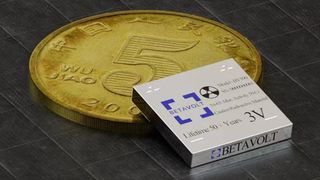Chinese company Betavolt has announced an atomic energy battery for consumers with a touted 50-year lifespan. The Betavolt BV100 will be the first product to launch using the firm’s new atomic battery technology, constructed using a nickel -63 isotope and diamond semiconductor material. Betavolt says that its nuclear battery will target aerospace, AI devices, medical, MEMS systems, intelligent sensors, small drones, and robots – and may eventually mean manufacturers can sell smartphones that never need charging.
Buying an electronics product that can go mains-free for 50 years would be amazing. However, the BV100, which is in the pilot stage ahead of mass production, doesn’t offer a lot of power. This 15 x 15 x 5mm battery delivers 100 microwatts at 3 volts. It is mentioned that multiple BV100 batteries can be used together in series or parallel depending on device requirements. Betavolt also asserts that it has plans to launch a 1-watt version of its atomic battery in 2025.
The new BV100 is claimed to be a disruptive product on two counts. Firstly, a safe miniature atomic battery with 50 years of maintenance-free stamina is a breakthrough. Secondly, Betavolt claims it is the only company in the world with the technology to dope large-size diamond semiconductor materials, as used by the BV100. It is using its 4th Gen diamond semiconductor material here.
In its press release about the development and production plans for the BV100, Betavolt talks about how its atomi

(Image credit: Betavolt)
The new, improved levels of safety stem from the choice of materials. Betavolt’s battery uses a nickel -63 isotope as the energy source, which decays to a stable isotope of copper. This, plus the diamond semiconductor material, helps the BV100 operate stably in environments ranging from -60 to 120 degrees Celsius, according to the firm. Betavolt boasts that this battery technology is “way ahead” of European and American academic and commercial institutions.
How does Betavolt make this battery? We’ve already mentioned the essential materials, but the above diagram provides an excellent overview. The BV100 is made by “placing a 2-micron-thick nickel -63 sheet between two diamond semiconductor converters.” This construction relies on Betavolt’s “unique single-crystal diamond semiconductor that is just 10 microns thick.”
So, the current BV100 or its 1-watt successor scheduled for next year may not sound so impressive regarding peak power output. Betavolt will be well aware of devices with a greater thirst for power and teases that it is investigating isotopes such as strontium- 90, promethium- 147, and deuterium to develop atomic energy batteries with higher power levels and even longer service lives – up to 230 years.

